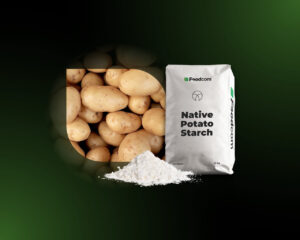- Demand for potato starch is increasing in 2024 due to interest in natural and gluten-free products.
- Yield variability due to extreme weather conditions is affecting the supply and prices of starch.
- Potato starch is gaining importance not only in the food industry, but also in the cosmetics and paper industries.
- Investments in new processing technologies are helping producers to increase productivity and product quality.
2024 brings significant changes to the potato starch market, driven by a growing interest in natural and gluten-free products. Consumers around the world are looking for foods with simple ingredients, which is driving demand for potato starch, which is widely used as a thickening and stabilising ingredient. Its popularity is growing not only in the food sector, but also in the cosmetics and paper industries, where its unique properties are being exploited.
At the same time, manufacturers are facing the challenges of global changes, such as rising production and transport costs, as well as changing climatic conditions. In this article, we will analyse these factors, looking at both global trends and specific developments in particular regions of the world.
Market dynamics
The potato starch market is characterised by significant fluctuations in supply and demand as a result of a number of global factors. Growing interest in natural and gluten-free products continues to drive demand, particularly in the food sector, where potato starch acts as a thickener and stabiliser in many processed products. At the same time, producers are struggling with rising raw material and logistics costs, which has a direct impact on market prices.
The supply of potato starch depends on factors such as the variability of the potato crop, largely shaped by weather conditions. This year, extreme weather conditions such as droughts in some parts of Europe and excessive rainfall in Asia have reduced yields in some regions, limiting the availability of raw material. As a result, production costs and market prices for starch have increased.
The growing demand for gluten-free and clean label foods is one of the main factors shaping the market. Consumers are paying more and more attention to the composition of products, leading manufacturers to turn to natural ingredients, such as potato starch, as an alternative to more processed fillers. At the same time, in the industrial sector, potato starch is gaining ground as an environmentally friendly substitute for synthetic thickening agents, further driving its demand.
In response to these challenges, starch producers are investing in new processing technologies to improve product quality and increase production efficiency. Modified potato starch, which has grown in popularity, plays a special role due to its improved properties, such as stability over a wide temperature range and improved texture in food products. These developments not only add value to the product, but also allow companies to meet the needs of increasingly demanding consumers.
Regional analysis of the potato starch market
The potato starch market is developing with different dynamics in different regions of the world. Each faces different challenges and opportunities, depending on climatic conditions, agricultural infrastructure and specific consumer needs.
Europe
Europe is one of the largest producers of potato starch in the world, with countries such as Germany, the Netherlands and Poland playing a key role in its production and export. Thanks to favourable climatic conditions and a developed processing infrastructure, starch production in these countries is stable. In 2024, the region is seeing an increase in demand for starch, particularly in the food sector, where consumers are increasingly opting for natural products. Poland, Germany and the Netherlands are not only large producers, but also important exporters, supplying starch to other European and non-European markets.
In the European region, there is also growing interest in modified potato starch, which is used in products with improved properties, such as bakery products, sauces or baby food. However, producers face the challenge of increasingly stringent regulations on sustainable production and greenhouse gas emissions, forcing them to invest in greener processing technologies.
North America
In the US and Canada, the potato starch market is growing rapidly, driven by increasing demand for gluten-free products and clean label foods. Consumers in North America are increasingly choosing products that are perceived to be natural and healthy, increasing demand for potato starch as a replacement for more processed fillers and thickeners. It is worth noting that the US is also an important market for processed products in which potato starch plays an important role as a stabilising and texturising agent.
Asia-Pacific
The Asia-Pacific region, especially countries such as China, Japan and India, is one of the fastest growing markets for potato starch. Changes in food preferences, rising incomes and population growth are fostering a growing demand for processed foods, in which potato starch is a key ingredient. In particular, China, which is one of the largest consumers of starch, is increasing its production to meet the needs of its domestic market, while exporting the surplus to other countries in the region.
However, weather variability and agricultural infrastructure challenges may be a constraint to further production growth. Countries such as India are facing climate problems, which is affecting potato yields and therefore starch production.
South America
In South America, particularly Brazil, potato starch production is growing, although the sector is still less developed compared to Europe and North America. Brazil, which is one of the larger agricultural producers in the region, is investing in potato crop development and starch processing in order to meet the growing demand in both the domestic and international markets.
Africa and the Middle East
Although the markets in Africa and the Middle East are smaller compared to the other regions, they show potential for growth. Population growth and the development of the food sector in these regions are fostering a greater demand for processed products, which consequently increases the demand for potato starch. However, problems with infrastructure and climatic conditions can hinder the development of local production, making these regions more dependent on starch imports from other parts of the world.
Trends and forecasts
One of the key sectors driving demand for potato starch remains the food industry. Starch is widely used in the production of processed foods such as sauces, soups, pasta and snacks. Its thickening and stabilising properties make it an ideal addition to many products, and the growing interest in specialised diets (e.g. gluten-free diets) is further increasing demand.
In addition to the food industry, potato starch plays an important role in the industrial sector, especially in paper and textile production. Thanks to its binding and thickening properties, starch is used in manufacturing processes where it supports the creation of more sustainable products. As industry increasingly turns its attention to ecology and sustainability, potato starch is becoming an attractive alternative to chemical thickening agents.
Forecasts for the coming years indicate a stable development of the potato starch market, with a projected growth of 3.1% per year until 2030. The greatest growth is expected in the Asia-Pacific region, where a booming middle class and changing eating habits are contributing to an increasing demand for processed products. In Europe and North America, the market will maintain its position, driven by technological innovation and growing demand for products with differentiated properties.
Global Reports from Foodcom S.A.
Curious about what’s next for potato starch? Discover the latest trends and insights that will shape the final months of 2024. Visit our blog as we regularly update our global reports. Stay up to date with Foodcom S.A.
![Potato starch market analysis 2026 [Global Report] Potato starch market analysis 2026 [Global Report]](https://foodcom.pl/wp-content/uploads/2024/09/potato-starch-1520x760.png)







